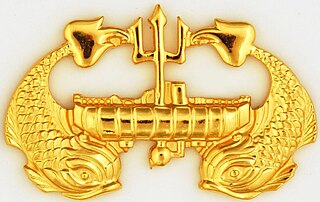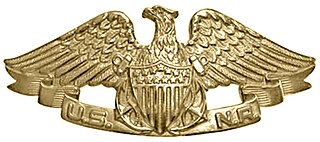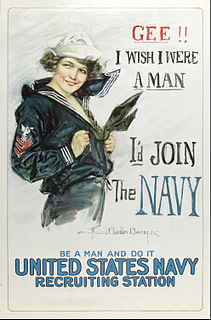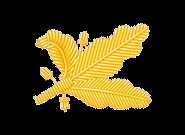The Submarine Warfare Insignia are worn by qualified submariners.

The SSBN Deterrent Patrol Insignia is a uniform breast pin worn by officers and enlisted sailors of the United States Navy's submarine service who have completed strategic deterrent patrols in nuclear ballistic or cruise missile submarines. It is awarded for different criteria than the Submarine Combat Patrol Insignia awarded for submarine patrols during World War II. Design of the SSBN pin shows a silver Lafayette-class submarine with superimposed Polaris missile and electron rings which signify the armament and nuclear-powered characteristics of the Fleet Ballistic Missile Deterrent Force. A scroll beneath the submarine holds up to six award stars, with one gold star authorized for each successful patrol, or a silver star for five successful patrols. At twenty (20) successful patrols, the SSBN pin is upgraded to a gold design. This insignia qualifies the veteran as a combat veteran, making the veteran eligible to join the VFW.

The Submarine Combat Patrol Insignia is a uniform breast pin worn by officers and men of the United States Navy's Submarine Service who have completed combat patrols during declared wars. Such patrols were last conducted during World War II.

The Deep Submergence Insignia is a uniform breast pin worn by officers, both men and a few women of the United States Navy's submarine service who are qualified in submarines and have completed one year of regular assignment to a Manned or Unmanned Deep Submersible. The badge was first approved on 6 April 1981.

The surface warfare insignia is a military badge of the United States Navy which is issued to U.S. Navy personnel who are trained and qualified to perform duties aboard United States surface warships. There are presently four classes of the surface warfare pin, being that of line, staff, special operations, and enlisted. The line and enlisted surface warfare badges may be earned by United States Coast Guard personnel assigned to Navy commands. The various badge types are as follows:

The Small Craft Insignia is a military award of the United States Navy which was first created in the 1970s following the close of the Vietnam War. The intent in creating the Small Craft Pin was to give recognition to the specially trained naval personnel who comprised the inshore boat units and river assault commands.

Naval Reserve Merchant Marine Insignia was a breast insignia of officers in the United States Merchant Marine who also served in the United States Navy or United States Navy Reserve. The insignia was replaced by the Strategic Sealift Officer Warfare Insignia (SSOWI) in June 2011, per OPNAVINST 1534.1D.

The diver insignia are qualification badges of the uniformed services of the United States which are awarded to servicemen qualified as divers. Originally, the diver insignia was a cloth patch decoration worn by United States Navy divers in the upper-portion of the enlisted service uniform's left sleeve during the first part of World War II, when the rating insignia was worn on the right sleeve. When enlisted rating insignia were shifted to the left sleeve in late World War II, the patch shifted to the upper right sleeve. The diving patch was created during World War II, and became a breast insignia in the late 1960s.

The Air Force Commander's Insignia is an insignia of the United States Air Force and United States Space Force, that has been in existence since 2002. Also known as the USAF Commander's Badge, the Air Force Commander's Insignia is awarded to any Air Force officer who holds an established command billet within the United States Air Force.

The U.S. military issues instructor badges to specially training military personnel who are charged with teaching military recruits the skills they need to perform as members of the U.S. Armed Forces or teach continuing education courses for noncommissioned officers and officers in the military. With the exception of the U.S. Army and U.S. Coast Guard, these badges are considered temporary military decorations and must be surrendered upon completion of one's duty as a military instructor. Because of this, the U.S. Air Force, U.S. Navy, and U.S. Marine Corps award Drill Instructor Ribbons as a permanent decoration to recognize service members who have qualified and performed as military instructors.

Mess dress uniform is the most formal type of uniforms used by military personnel, police personnel, and other uniformed services members. It frequently consists of a mess jacket, trousers, white dress shirt and a black bow tie, along with orders and medals insignia. Design may depend on regiment or service branch, e.g. army, navy, air force, marines, etc. In Western dress codes, mess dress uniform is the supplementary alternative equivalent to the civilian black tie for evening wear or black lounge suit for day wear although military uniforms are the same for day and evening wear. Mess dress uniforms are typically less formal than full dress uniform, but more formal than service dress uniform.

Identification badges of the Uniformed Services of the United States are insignia worn by service members conducting special duties, many of which can be awarded as permanent decorations if those duties are performed successfully. There are a few identification badges that are awarded to all services, others are specific to a uniform service. The Office of the President and Vice President and department/service headquarters badges are permanent decorations for those who successfully serve in those assignments. Some of the service level identification badges can be permanent decorations and others are only worn by a service member while performing specific duties, such as the Military Police Badge.

Insignias and badges of the United States Navy are military badges issued by the United States Department of the Navy to naval service members who achieve certain qualifications and accomplishments while serving on both active and reserve duty in the United States Navy. Most naval aviation insignia are also permitted for wear on uniforms of the United States Marine Corps.

Insignia and badges of the United States Marine Corps are military "badges" issued by the United States Department of the Navy to Marines who achieve certain qualifications and accomplishments while serving on both active and reserve duty in the United States Marine Corps.

Sea Scouts is a program of the Boy Scouts of America for young men and women ages 14 through 20.
The uniform and insignia of the Boy Scouts of America (BSA) gives a Scout visibility and creates a level of identity within both the unit and the community. The uniform is used to promote equality while showing individual achievement. While all uniforms are similar in basic design, they do vary in color and detail to identify the different membership divisions of Cub Scouting, Scouts BSA and Venturing. Many people collect BSA insignia such as camporee and jamboree emblems, council shoulder strips and historical badges.

The uniforms of the United States Navy include dress uniforms, daily service uniforms, working uniforms, and uniforms for special situations, which have varied throughout the history of the navy. For simplicity in this article, officers refers to both commissioned officers and warrant officers.
Command Ashore insignia, formerly known as the Command Ashore/Project Manager insignia, is a breast insignia of the United States Navy and the United States Coast Guard.

The Navy Supply Corps is the United States Navy staff corps concerned with supply, logistics, combat support, readiness, contracting, and fiscal matters.

The National Oceanic and Atmospheric Administration Commissioned Officer Corps, one of the eight uniformed services of the United States, has the authority to issue various awards and commendations to its members. These include individual honor awards, unit honor awards, service awards, training ribbons and qualification insignia. NOAA Corps awards and decorations include:



















